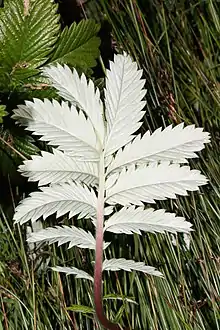Argentina pacifica
Argentina pacifica, sometimes called pacific silverweed,[1] silverweed cinquefoil,[2] or simply silverweed,[3] is a low-growing perennial (6") with pinnately compound green leaves with silvery undersides. It is a member of the species aggregate known as Argentina anserina or Potentilla anserina.[4] The yellow, saucer-shaped flowers appear late spring through summer. Pacific silverweed spreads very quickly in moist areas. Preferring salt marshes, river estuaries and shorelines, they are often seen growing alongside springbank clover.[5] They need sun and regular water.
| Argentina pacifica | |
|---|---|
 | |
| Scientific classification | |
| Kingdom: | Plantae |
| Clade: | Tracheophytes |
| Clade: | Angiosperms |
| Clade: | Eudicots |
| Clade: | Rosids |
| Order: | Rosales |
| Family: | Rosaceae |
| Genus: | Argentina |
| Species: | A. pacifica |
| Binomial name | |
| Argentina pacifica | |
| Synonyms | |
| |
Pacific silverweed is important in Pacific Northwest coastal indigenous cultures. Indigenous people dig for its edible roots. As an important vegetable, families maintained rights to access patches through potlatch law. [6] New plants can grow from small root fragments, and with some attention families could guarantee patches persisted for generations "over hundreds, even thousands of years".[7]
Northwest Coast peoples used to dig them in spring with yew-wood shovels before pit-cooking them or boiling them with eulachon grease. Cooked roots have a slightly bitter sweet-potato flavour. Northwest Coast peoples also washed them or mashed them into cakes and dried them for winter.[5]
References
- Chuck Kozak (1999). "An incomplete and ever-evolving catalogue of native plants of Montara Mountains". Retrieved 4 February 2015.
- Paul Slichter. "Cinquefoils West of the Cascade Mountains of Oregon and Washington". Retrieved 4 February 2015.
- "Washington Native Plant Society". Retrieved 4 February 2015.
- Arne Rousi (1965). "Biosystematic studies on the species aggregate Potentilla anserina L.". Annales Botanici Fennici. 2 (1): 47–112. JSTOR 23724290.
- Turner, Nancy (2004). Plants of Haida Gwaii (Second ed.). Winlaw BC: SONO NIS PRESS. pp. 140–141. ISBN 1-55039-176-3.
- Turner, Nancy (9 January 2017). ""Expert Opinion of Dr Nancy J. Turner"". Nancy Turner.
- Deur, Douglas (2005). Keeping it Living: Traditions of Plant Use and Cultivation on the Northwest Coast of North America. Seattle, Washington: University of Washington Press. ISBN 0774812672.